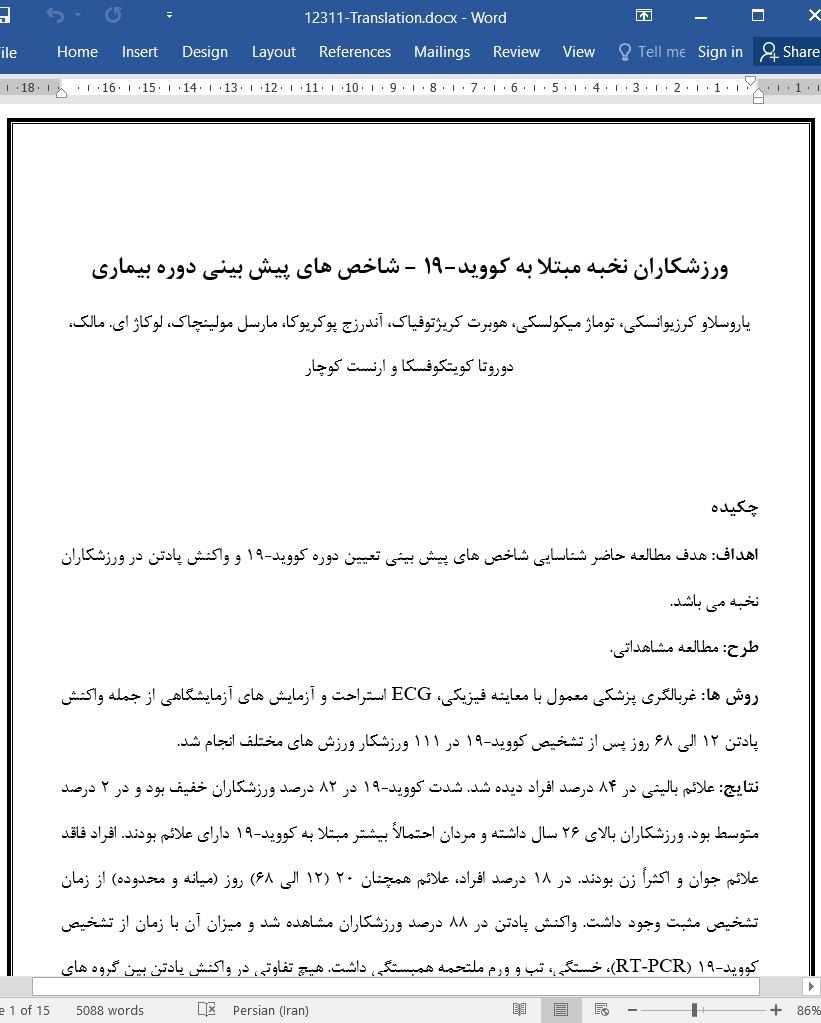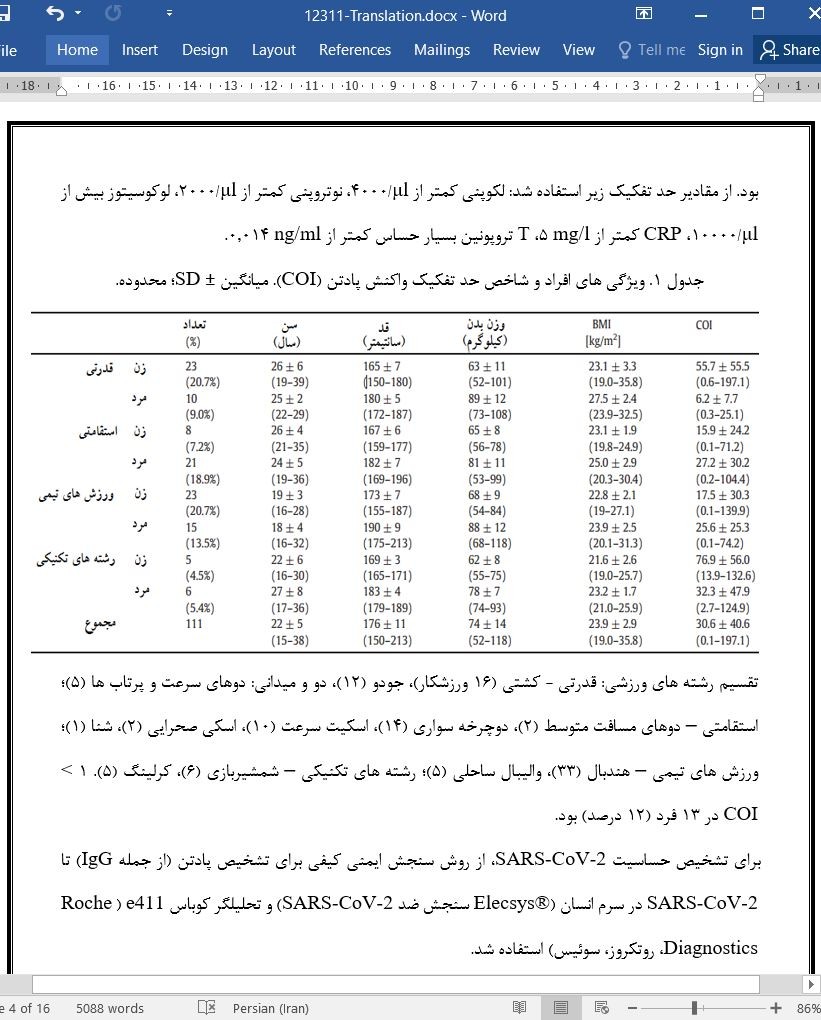
ورزشکاران نخبه مبتلا به کووید-19 - شاخص های پیش بینی دوره بیماری
چکیده
اهداف: هدف مطالعه حاضر شناسایی شاخص های پیش بینی تعیین دوره کووید-19 و واکنش پادتن در ورزشکاران نخبه می باشد.
طرح: مطالعه مشاهداتی.
روش ها: غربالگری پزشکی معمول با معاینه فیزیکی، ECG استراحت و آزمایش های آزمایشگاهی از جمله واکنش پادتن ۱۲ الی ۶۸ روز پس از تشخیص کووید-19 در ۱۱۱ ورزشکار ورزش های مختلف انجام شد.
نتایج: علائم بالینی در ۸۴ درصد افراد دیده شد. شدت کووید-19 در ۸۲ درصد ورزشکاران خفیف بود و در ۲ درصد متوسط بود. ورزشکاران بالای ۲۶ سال داشته و مردان احتمالاً بیشتر مبتلا به کووید-19 دارای علائم بودند. افراد فاقد علائم جوان و اکثراً زن بودند. در ۱۸ درصد افراد، علائم همچنان ۲۰ (12 الی 68) روز (میانه و محدوده) از زمان تشخیص مثبت وجود داشت. واکنش پادتن در ۸۸ درصد ورزشکاران مشاهده شد و میزان آن با زمان از تشخیص کووید-19 (RT-PCR)، خستگی، تب و ورم ملتحمه همبستگی داشت. هیچ تفاوتی در واکنش پادتن بین گروه های متمایز از نظر رشته ورزشی (0.50 = p) و جنسیت (0.59 = p) وجود نداشت و واکنش پادتن با BMI (0.12 = p)، سن (0.13 = p)، تعداد علائم (0.43 = p) و مدت زمان آن ها (0.19 = p) همبستگی نداشت.
نتیجه گیری: شدت کووید-19 در ورزشکاران نخبه عمدتاً خفیف و بدون عوارض می باشد. ورزشکاران پس از دو هفته بدون علائم می توانند به ورزش باز گردند و معمولاً به غربالگری دوباره قلب نیازی نیست. تعیین پادتن شاخص مفیدی برای بیماری کووید-19 قبلی بوده و از برخی از علائم می توان به عنوان شاخص پیش بینی واکنش پادتن استفاده نمود.
• شدت کووید-19 در ورزشکاران نخبه عمدتاً خفیف و بدون عوارض است.
• ورزشکاران پس از دو هفته بدون علائم می توانند به ورزش باز گردند و معمولاً به غربالگری دوباره قلب نیازی نیست.
• تعیین پادتن شاخص مفیدی برای بیماری کووید-19 قبلی است واز برخی از عوارض می توان به عنوان شاخص پیش بینی واکنش پادتن استفاده نمود.
5. نتیجه گیری
دوره کووید-19 در ورزشکاران نخبه عمدتاً خفیف و فاقد عوارض است. ورزشکاران مرد بالای 26 سال به احتمال زیاد دچار کووید-19 دارای علائم شده در حالی که زنان جوان تر بیشتر دچار کووید-19 فاقد علائم می گردند. معمولاً، به غربالگری دوباره قلب نیازی نبوده و ورزشکاران می توانند پس از دو هفته فاقد علائم به ورزش برگردند. ثابت شده تعیین پادتن شاخص مفیدی برای ابتلای قبلی به SARS-CoV-2 بوده و باید به ایجاد استراتژی حفاظتی پیش از رویدادهای مهم ورزشی در دوره کووید-19 کمک نماید.
Abstract
Objectives The aim of the study was to identify predictors determining the course of COVID-19 and antibody response in elite athletes.
Design Observational study.
Methods Routine medical screening with physical examination, resting ECG, and laboratory tests including antibody response was performed 12–68 days after the diagnosis of COVID-19 in 111 athletes of different sports.
Results Clinical symptoms were observed in 84% of subjects. The severity of COVID-19 was mild in 82% of athletes and moderate in 2% of cases. Athletes aged above 26 and male were more likely to develop symptomatic COVID-19. Asymptomatic subjects were younger and predominantly female. In 18% of subjects, symptoms were still present 20 (12–68) days (median and range) since positive diagnosis. Antibody response was observed in 88% of athletes, and its magnitude correlated with time since diagnosis of COVID-19 (RT-PCR), fatigue, fever, and conjunctivitis. There were no differences in antibody response between groups distinguished by sports discipline (p = 0.50), and sex (p = 0.59), and antibody response did not correlate with BMI (p = 0.12), age (p = 0.13), the number of symptoms (p = 0.43) or their duration (p = 0.19).
Conclusions The severity of COVID-19 in elite athletes is predominantly mild and without complications. Athletes can return to sport after two symptom-free weeks and additional heart screening is usually not required. Determination of antibodies has been shown to be a useful indicator of a previous COVID-19 disease, and some symptoms can be used as predictors of antibody response.
• The severity of COVID-19 in elite athletes is predominantly mild and without complications.
• Athletes can return to sport after two symptom-free weeks and additional heart screening is usually not required.
• Determination of antibodies has been shown to be a useful indicator of a previous COVID-19 disease, and some symptoms can be used as predictors of antibody response.
5. Conclusion
The course of COVID-19 in elite athletes is predominantly mild and without complications. Male athletes aged above 26 are more likely to develop symptomatic COVID-19, whereas younger females are more frequently asymptomatic. Usually, additional heart screening is not required, and athletes can return to play after two asymptomatic weeks. Determination of antibodies has proved to be a useful indicator of past infection of SARS-CoV-2, and should help build the protection strategy before the major sports events during the COVID-19 pandemic.
چکیده
1. مقدمه
2. روش ها
3. نتایج
4. بحث
5. نتیجه گیری
منابع
Abstract
1. Introduction
2. Methods
3. Results
4. Discussion
5. Conclusion
References
- اصل مقاله انگلیسی با فرمت ورد (word) با قابلیت ویرایش
- ترجمه فارسی مقاله با فرمت ورد (word) با قابلیت ویرایش، بدون آرم سایت ای ترجمه
- ترجمه فارسی مقاله با فرمت pdf، بدون آرم سایت ای ترجمه



